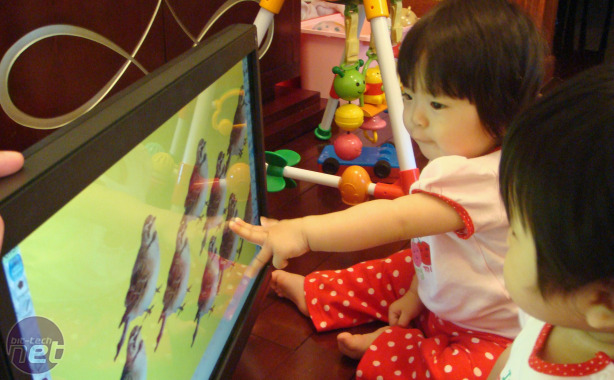How to build a touchscreen all-in-one PC
July 9, 2010 | 08:46

Pros and cons of touchscreens
After constructing this short project, I thought I'd go through the feelings and experiences of using a touchscreen such as Albatrons for a PC instead of your smartphone or tablet.The benefits of a touchscreen PC
- One thing that makes a touchscreen awesome is that you don't need to find a square of space for the conventional interfaces: no keyboard, no mouse. This, combined with a screen that you can wipe clean means the PC can go in the kitchen or even outside as long as it doesn't rain.
- Combined with the Asus Ion board, the other benefit is having it as a silent home theatre PC for the bedroom or another small room; somewhere other than the de-facto big HDTV perhaps. You can either use the included remote control in the Asus motherboard box, or manually do it with an extended pinkie.
- Albatron's optical touch technology is cheaper than capacitive technologies, and potentially can be used on any size or type display; all it requires is a firmware update. This can bring the cost down, or make any monitor you already own possibly touch-upgradable.
- It benefits children. Whether you have your own or have relations with young kids, from any background, they will all try to touch things. It's an intuitive reaction, unlike using a mouse which isn't as easily understood by the very young. However, using PCs as an educational tool - Google Earth is a great example - or just simply for entertainment, it has obvious advantages because touchscreen introduces them to new things more natively.

At just one year old, these two ladies were just a little too young to understand, but that didn't stop them trying! Using Tuxpaint, their mum and grandma used the stamps to teach them animal names.
The failings of a touchscreen PC
- There are still considerable drawbacks though - for starters the software for multi-touch just isn't there, which is admittedly something I didn't realise at first. Just like "HD Ready" TVs supporting HD inputs, Albatron's monitor supports multi-touch but the software just isn't there to make use of it. Microsoft may have made the touchscreen interface a native part of Windows 7, but it's still only single finger that emulates a mouse. There's no "make a selection box with two fingers" unfortunately.
Thinking you'll be able to get a Microsoft Surface any time soon is not really going to happen. Unfortunately while we've been spoiled by a multitude of smartphones, mainstream PC software has yet to catch up.
- One immediate disadvantage to using a touchscreen for a HTPC is that you need to get off your arse to use it. So, yes, you can dump the mouse and keyboard but you can't Go-Go Gadget extend your arms. Plus, you can get the HippoRemote app that uses VNC to control your mouse over WiFi on your smartphone. That's a lot cheaper than buying a touchscreen and cybernetic arms.
- Although a kitchen will probably benefit the most from a PC without a keyboard or mouse, none of the screens we've seen are waterproof, so now for these rooms are a no-go area.
- A touchscreen with a thin-client would be cheaper and could be rolled out around the house; it could integrated into a home management setup. Unfortunately, that requires more considerable investment and even more specialist software.
Other, final thoughts
The Asus AT3IONT-I is an excellent little board and even overclocks a bit (not that it makes much of a difference). Although it seems expensive the bundle is worth it if you really want the whole kit, otherwise you might as well just buy a-n-other Ion board.Throw in an SSD like we did and it's the true definition of silence because it has absolutely no moving parts: no PSU fan, no hard drive, no CPU fan. However, we're not at all convinced that it will be handle lots of hard drives well.
The remote control and receiver are not bad, but like all bundled extras it's a bit cheap-and-cheerful compared to the Microsoft-spec Media Center hardware.

MSI MPG Velox 100R Chassis Review
October 14 2021 | 15:04








Want to comment? Please log in.